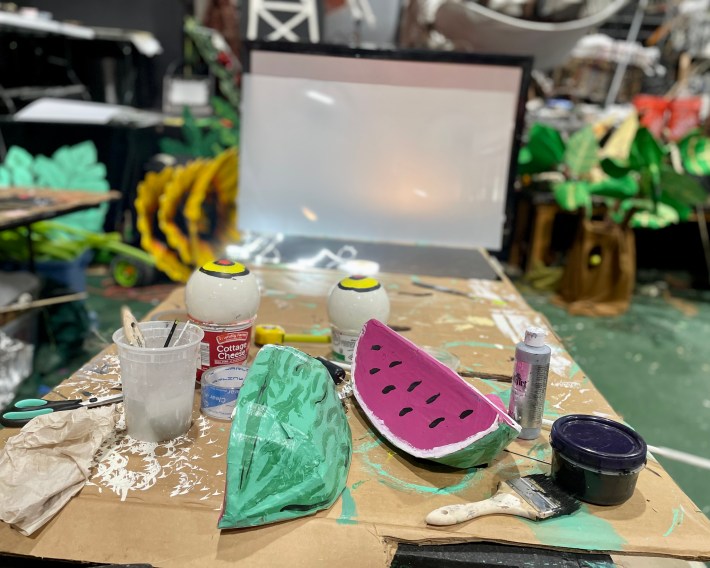“Bare!” calls a volunteer, her voice lifting above the noise of the puppetry workshop.
“Bones!” a dozen or more voices respond.
“Bare!” She calls again, more audible in the quieting space.
“Bones!” Nearly 30 voices respond as most, but not all, of the artists and volunteers filling the Avalon Theatre have put down their tools and larger-than-life-puppets to listen.
With that call and response, it's time for BareBones Productions’ afternoon announcements at the final community workshop of the 2024 season. Performances begin in less than a week, and materials and people are everywhere, with monsters and trees propped against folding tables. Puppets are still in the process of “being born,” as volunteers embellish frogs and craft whale bones from PVC.
Now in its 31st year, BareBones’ Halloween Puppet Extravaganza begins on Thursday, October 31, and runs nightly through Sunday, November 3, at the north end of Powderhorn Lake.
The day's announcements match the spirit of BareBones and its open community ethos, with artists and volunteers sharing—among other things—the menu for the day's free community lunch, a request for help moving a giant puppet, and to report a lost pair of glasses. This sharing is at the foundation of BareBones’ operations.

The group always draws the inspirations for its annual production from the community. In early September, BareBones welcomed nearby residents to share their ideas at vision/storyboarding sessions at Powderhorn Rec Center for a performance investigating “grief, death, ancestors, loss, and remembering.”
From those late summer sessions, BareBones co-directors Walken Schweigert and Jäc Pau created the 2024 framework for an exploration of the interplay between technology, climate change, and genocide. Titled When Calamity Strikes, this year’s extravaganza grew directly from these imagining sessions, with the performances aiming to disrupt what the directors describe as “the common and problematic dichotomy between the ‘mechanical’ and the ‘natural.’”
And from proclamation come the puppets. There are scores and scores of them, ranging from mushrooms the size of a microwave to a frog-fighter jet hybrid with two tongues half the size of a city bus. These are not sock puppets or hand puppets (well, some are), but larger-than-life fabrications, some of which require four or more volunteers to operate. There are shadow puppets, giant kinetic sculpture puppets, stationary puppets, and projection screens.
And all of these puppets are made, for the most part, with DIY gumption and recycled pieces. “Whenever possible, materials are donated or found, including through dumpster diving,” explains Molly DeBower, the producer of When Calamity Strikes. DeBower traces the organization's origin to the DIY community of Minneapolis’s ’90s punk scene, with recycling and resourcefulness fundamental to BareBones.
Drawing from the detritus of our civilization, BareBones has built a menagerie from mountains of couch stuffing and fabric and cardboard. The puppets, many of them extinct animals, are grown out of all sorts of objects, held together with paint and ties and glue. Everywhere, old bicycle tubes act as the sinew of the artworks.
One of the largest puppets is a ghostly 20-foot frog, mounted on an antique wooden sulky, which is like a two-wheeled, horse drawn carriage. The frog’s skin is a plastic cover that may have at one time been old winter camouflage. As all the material comes from somewhere else, the origin matters less than how it's used. With painted beach balls for eyes and a wheelchair propping up its front, it moves with menace and gravity.

Stu, the large-puppet artist in charge of the frog, drew inspiration from the global biodiversity collapse and ongoing genocide. He wanted to respond to “the lights going out across Gaza, the children dying” by transforming the ghost frog’s hind legs into the tail fins of a fighter jet. Having the frog consume fireflies as it moves across the stage echoes the destruction in Palestine. “As a kid, I remember fireflies across my neighborhood, but now they’re basically gone,” he says. Two massive red fabric tongues shoot out of the frog’s mouth, and the firefly lights wink off as the frog consumes them.
Many of the moments and puppets in When Calamity Strikes draw from multiple sources, an amalgamation of materials and inspirations and processes. While the large puppet artists each have a puppet assigned, any volunteer can come in, help out, and stitch together a mushroom, or assist in stapling together a massive spider. Each puppet reflects whoever helped work on it, and whatever they brought with them to the Avalon Theatre that day.

Piper Smith is an artist working on Loomer, a massive robotic face that looms over the stage with a rotating eye and a clacking jaw. There are moments of artistic metaphor throughout the show—in this case, the face of Elon Musk, the arch techno-capitalist, appears on the paper mache newsprint covering the cardboard of Loomer’s body. It's not a detail Piper would have picked, but it adds to the nature of this terrifying, surveilling 10-foot-tall mask. “Fuck!” Piper says, laughing. “I hate this!”
Volunteers will work with and perform as many different puppets across a single show, as live musicians score their actions. The spectacle, like nature, like innovation, is fleeting, and will only last the four nights of the Extravaganza.
After the production, the puppets might go into the community, home with the artists or volunteers, or be recycled. (One volunteer wasn’t sure if he had enough room in his already full “puppet shed.”) Puppets might also reappear, in some form, in future Extravaganzas. Last year's birds, for instance, morphed into this year's fireflies.

The puppets are never quite finished, and never quite disappear. Build site volunteer anchor Erica chuckles that some puppets will probably be completed “sometime after the show.”
As one volunteer explained, the goal is not perfection, but something much bolder: “to put things into existence.”
BareBones 31st Halloween Extravaganza: When Calamity Strikes
Where: Powderhorn Park, 3400 15th Ave. S., Minneapolis (map here)
When: 6 p.m. November 1-3 (pushed back a day due to weather)
Tickets: $20 suggested donation; more info here







